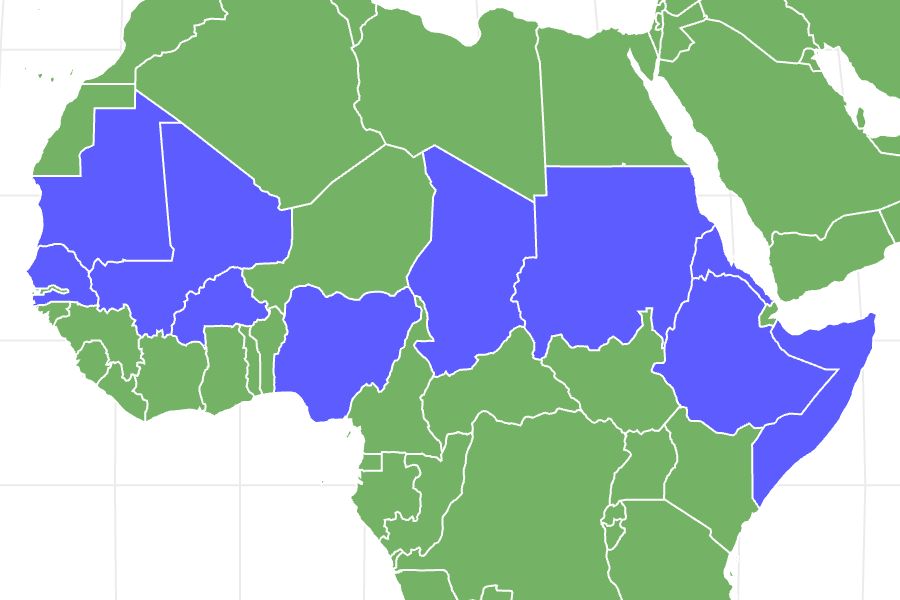Sulcata Tortoise
Centrochelys sulcata
Some cultures in Africa believe the sulcata tortoise is an intermediary between the people and their ancestors and gods.
Advertisement
Sulcata Tortoise Scientific Classification
- Kingdom
- Animalia
- Phylum
- Chordata
- Class
- Reptilia
- Order
- Testudines
- Family
- Testudinidae
- Genus
- Centrochelys
- Scientific Name
- Centrochelys sulcata
Read our Complete Guide to Classification of Animals.
Sulcata Tortoise Conservation Status
Sulcata Tortoise Facts
- Name Of Young
- Hatchling
- Group Behavior
- Solitary
- Fun Fact
- Some cultures in Africa believe the sulcata tortoise is an intermediary between the people and their ancestors and gods.
- Estimated Population Size
- Unknown, but the animal is listed as vulnerable or endangered
- Biggest Threat
- Hunting, poaching, habitat destruction
- Most Distinctive Feature
- Its size
- Other Name(s)
- African spurred tortoise
- Gestation Period
- About 75 days
- Litter Size
- 15 to 30
- Habitat
- Desert, dry savanna
- Predators
- Humans
- Diet
- Herbivore
- Type
- Reptile
- Common Name
- African spurred tortoise, spurred tortoise, African spur thigh tortoise
- Number Of Species
- 1
- Location
- Southern part of the Sahara Desert
View all of the Sulcata Tortoise images!
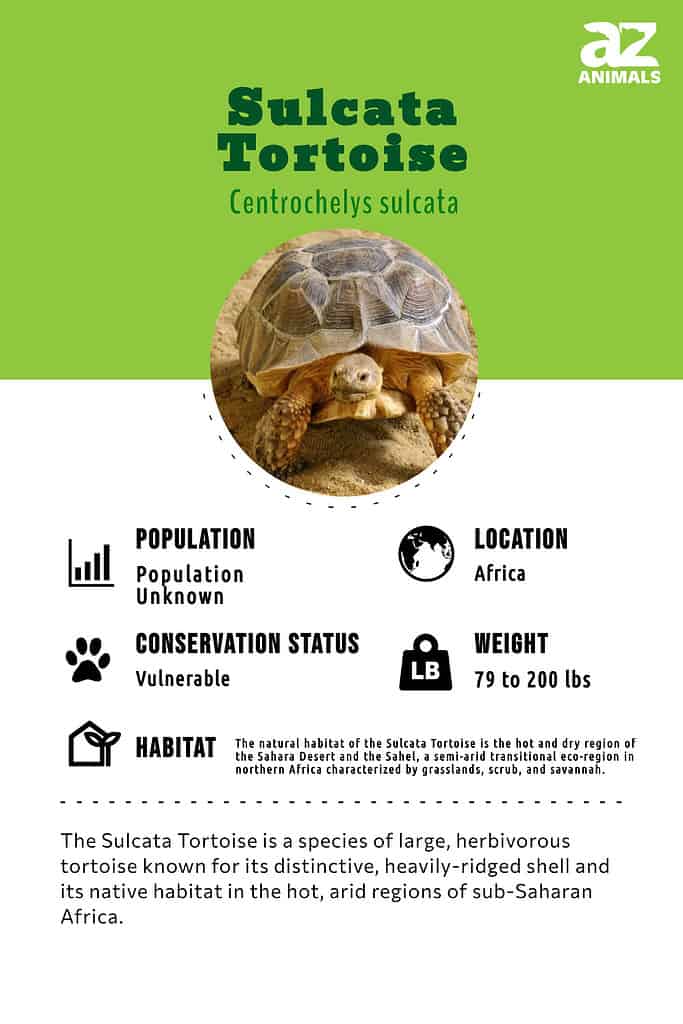
“The Sulcata Tortoise is the third biggest tortoise in the world.”
The populations of the Sulcata tortoise, also called the African spurred tortoise, are falling into the wild even as the tortoise is gaining in popularity as a pet. It’s an intelligent animal, and if its needs for ample housing, food, light, heat, and humidity are met, it can outlive even a young owner.
The problem is that a full-grown tortoise can be so large that a person with modest resources can’t handle its needs, and many of these tortoises end up in zoos or rescue centers.
Sulcata Tortoise Facts
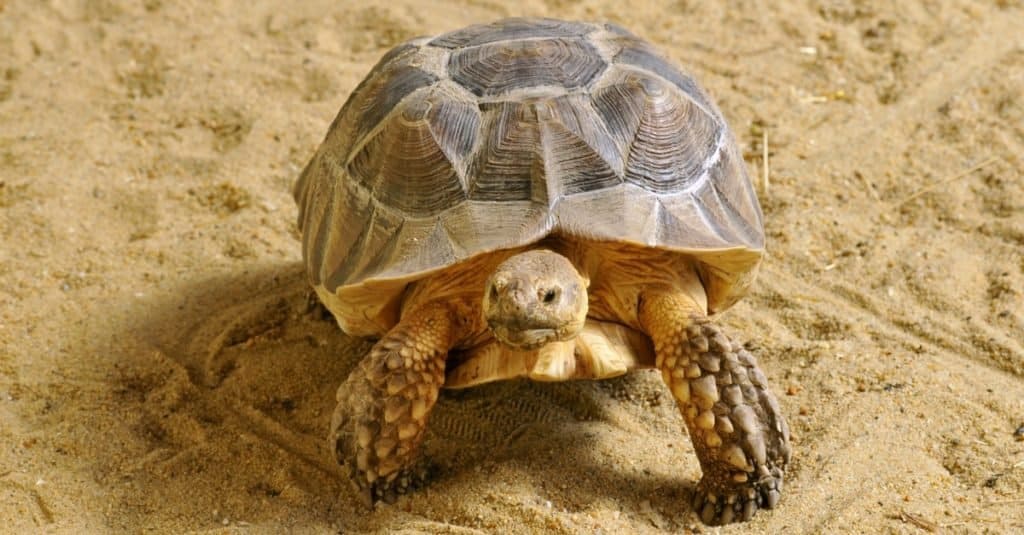
The sulcata tortoise is smaller than only two other types of tortoises, namely the Galapagos tortoise and the
Aldabra giant tortoise
.
©Christian Musat/Shutterstock.com
- The only two tortoises larger than the sulcata tortoises are the Galapagos tortoise and the Aldabra giant tortoise.
- Like many reptiles, the sex of a hatchling is probably determined by the temperature it was exposed to in the egg and not by chromosomes.
- Females seem to be a bit more protective of their nests than other turtles. They will try to see off an invader, usually by trying to ram them with the edge of their carapace. But other than this, she provides no care for eggs or hatchlings.
- The tortoise is a symbol of happiness and fertility in some Senegalese societies.
Evolution and Origins
The Sulcata tortoise originates from the Sahara Desert and the Sahel, which is a transitional ecological region located in northern Africa and characterized by semi-arid grasslands, scrub, and savannah.
The picture of Eunotosaurus africanus can be found on Wikimedia. This small reptile possessed a distinct feature: its ribs were thick and curved backward, creating a shield-like structure beneath its skin. Although unaware at the time, Eunotosaurus would eventually become the forefather of all turtles, tortoises, and terrapins.
The sulcata tortoise spurred tortoise, and African spur thigh tortoise is all names for this species. Turtles and tortoises are an ancient class of reptiles that date back approximately 220 million years.
Scientific name
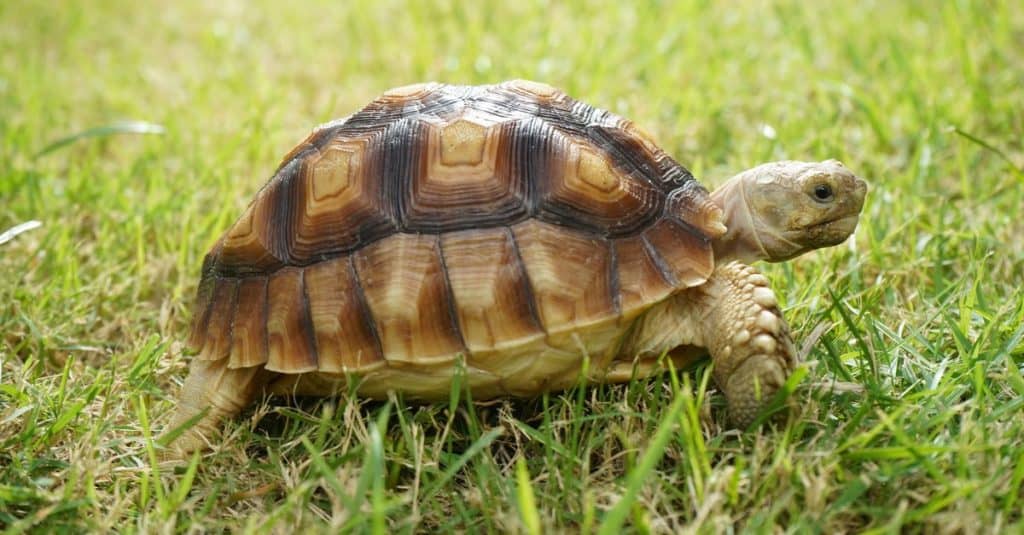
The scientific name of the Sulcata tortoise is either Centrochelys sulcata or Geochelone sulcata.
©Sutthiphong Chandaeng/Shutterstock.com
The Sulcata tortoise’s scientific name is Centrochelys sulcata or Geochelone sulcata. “Sulcata” is from the Latin sulcatus, which means furrowed and refers to the patterns on the animal’s shell. “Chelonia” and its derivatives come from the Greek word for turtle, and “chelys” means tortoise in Greek. The sulcata tortoise is the only species in its genus.
Different Types
Here are some different types of Sulcata Tortoise:
- Tortoise enclosure
- Baby Sulcata
- Tortoise breeds
- Tortoise habitat
- Giant tortoise
- Best tortoise
- Tortoise diet
- Tortoises eat
- Thighed tortoise
- Leopard tortoise
- Spur thighed
Appearance
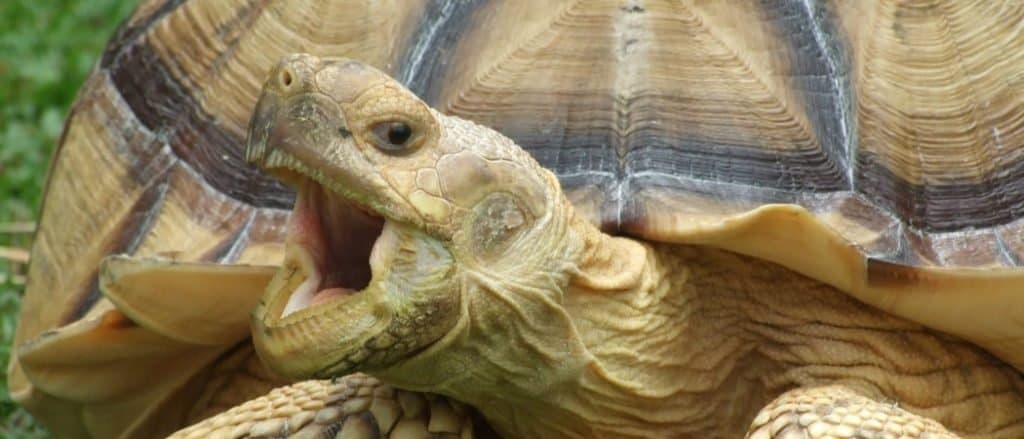
The African spurred tortoise is the biggest tortoise found on the African continent.
©YapAhock/Shutterstock.com
The African spurred tortoise is the largest tortoise on the African continent. It has a wide, oval shell that’s a bit flattened on the top and comes in shades of brown to yellow. The front and back of the shell are serrated, with the back edge turned up. The scutes, which are the keratin plates that cover the bone of the shell, have attractive annular rings. The bottom of the shell, or plastron is the color of old ivory.
The head of the tortoise is proportional, and it has a snub snout and an upper jaw with a small hook. It has thick, scaly skin that’s yellowish-brown or golden, and its feet are stubby for digging. Spurs on the back legs of the tortoise give it its other name African spurred tortoise, but no one knows what the spurs are for.
A full-grown sulcata tortoise can weigh between 79.3 and 110.13 pounds, though a big male can weigh 200 pounds. The biggest African-spurred tortoise weighed 232 pounds! Bigger tortoises are found in Sudan, which is a bit less dry than other areas. As is the case with many turtles and tortoises, males have longer and thicker tails than females and a concavity in the plastron that facilitates mating.
Behavior

Sulcata tortoises are active during the crepuscular period, which refers to the time around dawn or dusk. They tend to bask in the morning sunlight in order to regulate their body temperature.
©Osa Sumanohara/Shutterstock.com
Sulcata tortoises are crepuscular, which means they are out and about at dawn or dusk and will bask in the morning sun to regulate their body heat.
The large, stubby feet of the African spurred tortoise is ideal for digging, especially digging through sandy soil. So if’s too hot or too cold, the tortoise digs a burrow and shelters there until conditions improve. A sulcata tortoise burrow can be very spacious and can be as much as 49 feet deep and 98 feet long.
The burrow not only protects the cold-blooded animal from excessive heat and cold but provides them with enough humidity to prevent dehydration. It is even better if the burrows are muddy, for the tortoise will flip some mud on its back to keep cool. If the temperature is too high and there’s no mud, they’ll smear their own saliva over their legs to cool down.
Sometimes there is enough moisture in the air and soil for plants to grow around the tortoise’s burrow. This is beneficial for both the plants, which include succulents and grasses, and for the tortoise. The tortoise eats the plants, the plants are fertilized by the tortoise’s feces.
Sulcata tortoises are solitary and can be very aggressive toward other sulcata tortoises, even from birth. This is especially true of the males, who like to noisily ram each other. Hatchlings have been known to bang into and attempt to flip each other over. If ever a group of tortoises or any sort of chelonians get together, the group is called a bale.
Habitat
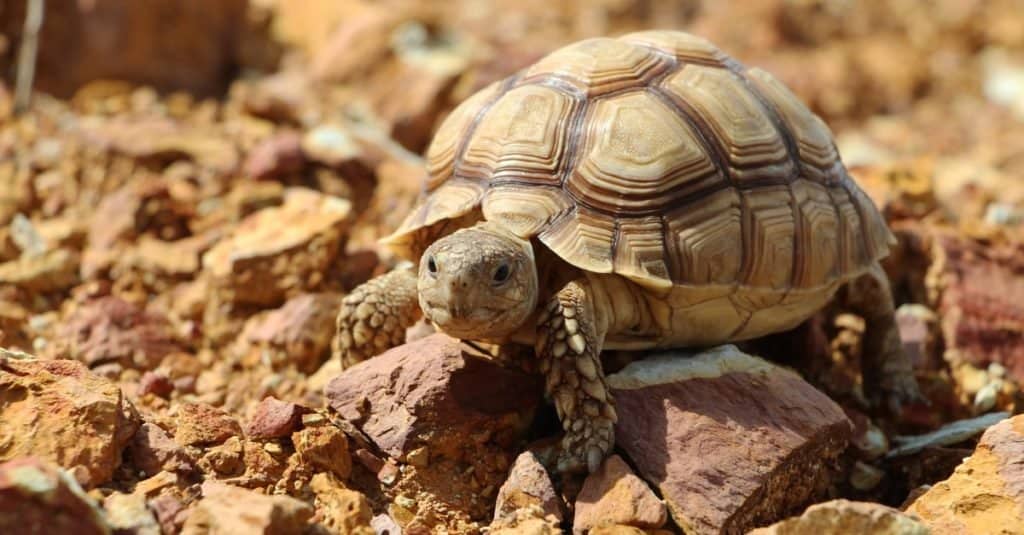
The sulcata tortoise inhabits regions that are characterized by hot and arid conditions.
©seasoning_17/Shutterstock.com
The sulcata tortoise lives in places that are hot and dry. This is why it’s found in such countries that are at least partly located in the Saharan desert such as Mauritania, Mali, Sudan, and Ethiopia.
Because the desert areas of these countries are hot during the day and cold at night, the tortoise spends the hottest and coldest part of the day in a burrow.
They come out to forage just before the sun rises and just after it sets and basks in the light and heat of the sun in the morning before it gets too hot.
Diet
The sulcata tortoise is an herbivore and eats such plant materials as grasses and succulents. They also eat lettuce and a type of clover called berseem. A tortoise kept as a pet can be fed ordinary weeds such as dandelions, and the animal can enjoy both the leaves and the flowers. They shouldn’t be given vegetables that have a lot of oxalates such as sorrel, kale, or broccoli.
As a large reptile with a slow metabolism, the sulcata tortoise can go for weeks without eating or drinking. When it finally comes upon a source of water, it can drink as much as 15 percent of its own weight. This means a 100-pound tortoise will drink 15 pounds of water at a sitting.
Predators and Threats
Though the ease of care of this tortoise makes it popular as a pet, it is endangered and disappearing in the wild. This is due to subsistence hunting for its meat as well as the destruction of its habitat due to overgrazing of cattle and other livestock.
Desertification is also a problem when it comes to sulcata tortoise conservation. Though it does live in the desert, it can’t live in a place that is so arid that there is nothing for it to eat.
“What eats the sulcata Tortoise?”
Humans hunt and eat the sulcata tortoise, which contributes to its declining numbers in the wild. Predators can also dig up eggs.
“What does the sulcata Tortoise eat?”
The sulcata tortoise eats plant matter that’s low in protein and high in fiber.
Reproduction and Life Cycle

The Sulcata tortoise’s endangered status can be attributed to the fact that it takes 15 years for them to attain sexual maturity.
©Poez/Shutterstock.com
Another reason that the sulcata tortoise is endangered is that it takes 15 years to reach sexual maturity. That and the fragmentation of its habitat makes reproduction for any one wild tortoise uncertain. The one bit of good news is that African spurred tortoises can breed throughout the year, even though the peak breeding time is shortly after the rains. This usually happens between September and November.
If there is more than one male vying for the attention of a female, the males will fight, with much grunting, groaning, and whistling. It is not uncommon for blood to be shed. Sometimes a male will be flipped over on his back, which is dangerous because of the difficulty of a large tortoise righting itself. A flipped-over tortoise can easily die from hyperthermia.
The victorious male circles around the female and then rams her before copulation, which is also vigorous and noisy.
After mating, the female will be gravid for about 60 days before she looks for a place to lay her eggs. She lays her eggs in a nest scooped out of the ground. She may dig a number of nests before she settles on a perfect place. Once there, she digs a hole about 2 feet across and 3 o 6 inches deep in loose soil with her front feet. She urinates many times into it.
When it’s finished, she digs another depression at the back of the first one with her back feet. This can take as many as five hours, depending on how easy the soil is to move.
When the female is satisfied with the nest, she lays an egg every 3 minutes or so until she has a clutch of between 15 and 30 eggs. Then she covers them, which can take another hour. The eggs hatch after 90 to 120 days, and the baby tortoises, or hatchlings are about 1.57 to 2.36 inches long and weigh less than half an ounce. Baby tortoises are golden or tan, and their carapaces are oval and serrated. A rare albino baby can sell for a great deal of money.
Hatchlings grow quickly and can be 6 to 10 inches long after a few years. A sulcata tortoise’s lifespan can be as long as 70 years, and some believe they can live much longer than this.
Sulcata tortoises can suffer from respiratory problems if the humidity in their housing is too high. They can also suffer from shell rot and softening of their bones due to an electrolyte imbalance. These problems can be treated by a veterinarian.
Population
The wild population of sulcata tortoises is unknown, but their numbers are declining. This is due to hunting them for food, damage to their habitat, and poaching, for people to buy their shells.
View all 293 animals that start with SSulcata Tortoise FAQs (Frequently Asked Questions)
Are sulcata tortoises carnivores, herbivores, or omnivores?
Sulcata tortoises are herbivores, which means they use plants for food.
Are sulcata tortoises good pets?
Though they are aggressive toward each other, sulcata tortoises are good pets. They appear to be intelligent, curious, and biddable toward their human companions, and they breed easily in captivity. The price of a sulcata tortoise varies. For some, the price can be as low as $50 while for others the price can be as high as $1000. Ivory-colored or albino tortoises are even pricier. The former can be as much as $2699, and the latter close to $1800.
Are sulcata tortoises easy to keep?
One of the reasons that sulcata tortoises are sought out as pets is they are easy to care for when they’re young as long as they are given the proper diet and housing. They also need the right levels of heat, light and humidity. However, the owner should be warned that they can grow to a very large size and a very old age and make arrangements for these possibilities.
How long do sulcata tortoises live?
The lifespan of sulcata tortoises is around 54 years on average and can be 70 years or longer.
Do sulcata tortoises bite?
Sulcata tortoises can bite, especially during the breeding season when males become especially aggressive, and females might want to protect their nests. They seem to be more likely to want to ram an intruder with the edge of their shells.
What do you feed a sulcata tortoise?
Sulcata tortoises need plant material for food. This can include weeds and even grass clippings as long as they are free of insecticides or herbicides. Pet owners should avoid fruit and vegetables high in oxalic acid such as cole vegetables.
How big do sulcata tortoises get?
A sulcata tortoise can grow to nearly 3 feet in length, and a big male can weigh close to 200 pounds, though weights between 79 and 100 pounds are more common. Any housing the owner provides must be big enough to accommodate such a large animal if the owner is determined to keep a full-grown sulcata tortoise. After the tortoise reaches a certain size it can’t be kept in the house because its burrowing instincts will cause it to damage the house.
What are the differences between desert tortoises and sulcata tortoises?
The differences between desert tortoises and sulcata tortoises include size, color variations, shells, habitat, and lifespan, among others.
What are the key differences between male and female sulcata tortoise?
The most obvious difference between adult male and female sulcata tortoises is their tail length. However, if you look closely, parts of their shell differ too, depending on their function. It is important to note that the shell of the sulcata tortoise is part of the skeletal system. Some major anatomical parts of the male and female sulcata tortoises differ. These include the carapaces, plastrons, gular scutes, and anal scutes.
Thank you for reading! Have some feedback for us? Contact the AZ Animals editorial team.
Sources
- American Tortoise Rescue, Available here: https://www.tortoise.com/blog/dont-buy-sulcata-tortoises-giants-overwhelm-us-rescues
- Tortoise Town, Available here: https://www.tortoisetown.com/
- Wikipedia, Available here: https://en.wikipedia.org/wiki/African_spurred_tortoise
- Animal Diversity Web, Available here: https://animaldiversity.org/accounts/Geochelone_sulcata/
- The Physics Factbook, Available here: https://hypertextbook.com/facts/1999/RachelShweky.shtml
- San Diego Zoo Wildlife Alliance, Available here: https://animals.sandiegozoo.org/animals/african-spurred-tortoise
- Fossil Rim Wildlife Center, Available here: https://fossilrim.org/animals/african-spurred-tortoise/
- Reptiles Magazine, Available here: https://www.reptilesmagazine.com/sulcata-tortoise-breeding/
- The Spruce, Available here: https://www.thesprucepets.com/sulcata-tortoise-1237267

